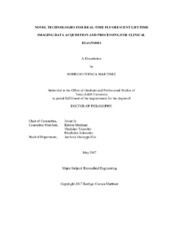| dc.description.abstract | Endogenous Fluorescence Lifetime Imaging (FLIM) is a noninvasive technique that has been explored with promising results in a wide range of biomedical applications, including clinical diagnosis. A central issue for the translation of FLIM into the medical field is the development of a robust, fast and cost-effective FLIM instrumentation suitable for in vivo tissue imaging. This thesis directly addressed some of the technical limitations that must be overcome to enable clinical applications of FLIM. The following specific aims were accomplished.
First, endogenous FLIM imaging and high-resolution reflectance confocal microscopy (RCM) were integrated into a multimodal bench-top optical system. This multimodal system was used to image oral epithelial cancer in a hamster cheek pouch model. Second, an endoscopic system for fast (0.5-4 frames/second) endogenous wide-field FLIM imaging of oral lesions was developed. The FLIM endoscope system is being evaluate at Texas A&M University College of Dentistry, where more than 80 patients presenting oral lesions suspected of pre-cancer or cancer have been imaged up to date. Third, a novel fluorescence lifetime estimation algorithm was developed to achieve robust, accurate, and real-time fluorescence lifetime estimation. This algorithm is enabling real-time FLIM image processing and visualization during the endoscopic examination of patients with suspicious oral lesions. Finally, the endoscopic endogenous FLIM data from suspicious oral lesions collected at the Texas A&M College of Dentistry was used to develop machine learning algorithms for automated identification of precancerous and cancerous lesions from benign oral epithelial lesions. Our results indicate that endogenous FLIM endoscopy can detect oral epithelial pre-cancer and cancer from a wider range of benign conditions, with levels of sensitivity and specificity above 85%.
Altogether, this work has demonstrated the potentials of endogenous FLIM endoscopy as a clinical tool for early detection of oral epithelial cancer. | en |


